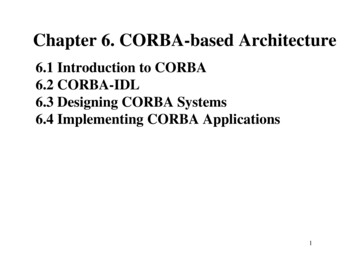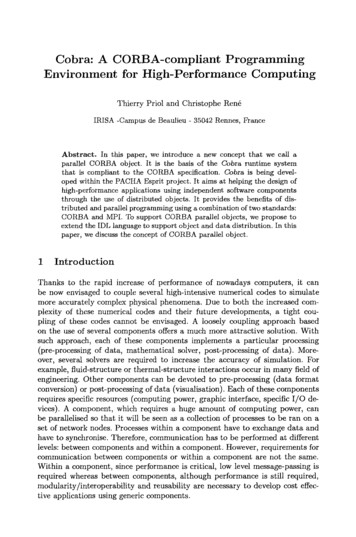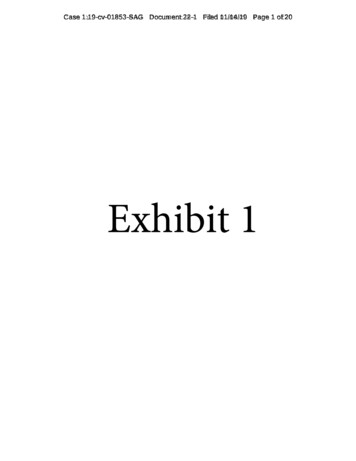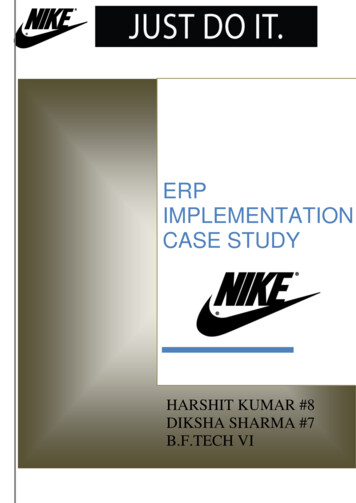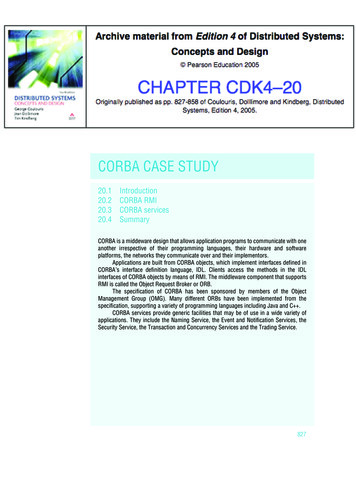
Transcription
20CORBA CASE STUDY20.120.220.320.4IntroductionCORBA RMICORBA servicesSummaryCORBA is a middeware design that allows application programs to communicate with oneanother irrespective of their programming languages, their hardware and softwareplatforms, the networks they communicate over and their implementors.Applications are built from CORBA objects, which implement interfaces defined inCORBA’s interface definition language, IDL. Clients access the methods in the IDLinterfaces of CORBA objects by means of RMI. The middleware component that supportsRMI is called the Object Request Broker or ORB.The specification of CORBA has been sponsored by members of the ObjectManagement Group (OMG). Many different ORBs have been implemented from thespecification, supporting a variety of programming languages including Java and C .CORBA services provide generic facilities that may be of use in a wide variety ofapplications. They include the Naming Service, the Event and Notification Services, theSecurity Service, the Transaction and Concurrency Services and the Trading Service.827
828CHAPTER 20 CORBA CASE STUDY20.1 IntroductionThe OMG (Object Management Group) was formed in 1989 with a view to encouragingthe adoption of distributed object systems in order to gain the benefits of object-orientedprogramming for software development and to make use of distributed systems, whichwere becoming widespread. To achieve its aims, the OMG advocated the use of opensystems based on standard object-oriented interfaces. These systems would be builtfrom heterogeneous hardware, computer networks, operating systems and programminglanguages.An important motivation was to allow distributed objects to be implemented inany programming language and to be able to communicate with one another. Theytherefore designed an interface language that was independent of any specificimplementation language.They introduced a metaphor, the object request broker (or ORB), whose role is tohelp a client to invoke a method on an object. This role involves locating the object,activating the object if necessary and then communicating the client’s request to theobject, which carries it out and replies.In 1991, a specification for an object request broker architecture known asCORBA (Common Object Request Broker Architecture) was agreed by a group ofcompanies. This was followed in 1996 by the CORBA 2.0 specification, which definedstandards enabling implementations made by different developers to communicate withone another. These standards are called the General Inter-ORB protocol or GIOP. It isintended that GIOP can be implemented over any transport layer with connections. Theimplementation of GIOP for the Internet uses the TCP protocol and is called the InternetInter-ORB Protocol or IIOP [OMG 2004a]. CORBA 3 first appeared in late 1999 and acomponent model has been added recently.The main components of CORBA’s language-independent RMI framework arethe following: An interface definition language known as IDL, which is illustrated early inSection 20.2 and described more fully in Section 20.2.3. An architecture, which is discussed in Section 20.2.2. The GIOP defines an external data representation, called CDR, which is describedin Section 4.3. It also defines specific formats for the messages in a request-replyprotocol. In addition to request and reply messages, it specifies messages forenquiring about the location of an object, for cancelling requests and for reportingerrors. The IIOP, an implementation of GIOP defines a standard form for remote objectreferences, which is described in Section 20.2.4.The CORBA architecture also allows for CORBA services – a set of generic servicesthat can be useful for distributed applications. These are introduced in Section 20.3which includes a more detailed discussion of the Naming Service, the Event Service, theNotification Service and the Security Service. For an interesting collection of articles onCORBA, see the CACM special issue [Seetharamanan 1998].
SECTION 20.2 CORBA RMI 829Before discussing the above components of CORBA, we introduce CORBA RMIfrom a programmer’s point of view.20.2 CORBA RMIProgramming in a multi-language RMI system such as CORBA RMI requires more ofthe programmer than programming in a single-language RMI system such as Java RMI.The following new concepts need to be learned: the object model offered by CORBA; the interface definition language and its mapping onto the implementationlanguage.Other aspects of CORBA programming are similar to those discussed in Chapter 5. Inparticular, the programmer defines remote interfaces for the remote objects and thenuses an interface compiler to produce the corresponding proxies and skeletons. But inCORBA, proxies are generated in the client language and skeletons in the serverlanguage. We will use the shared whiteboard example introduced in Section 5.5 toillustrate how to write an IDL specification and to build server and client programs.CORBA's object model The CORBA object model is similar to the one described inSection 5.2, but clients are not necessarily objects – a client can be any program thatsends request messages to remote objects and receives replies. The term CORBA objectis used to refer to remote objects. Thus, a CORBA object implements an IDL interface,has a remote object reference and is able to respond to invocations of methods in its IDLinterface. A CORBA object can be implemented by a language that is not objectoriented, for example without the concept of class. Since implementation languages willhave different notions of class or even none at all, the class concept does not exist inCORBA. Therefore classes cannot be defined in CORBA IDL, which means thatinstances of classes cannot be passed as arguments. However, data structures of varioustypes and arbitrary complexity can be passed as arguments.CORBA IDL A CORBA IDL interface specifies a name and a set of methods that clientscan request. Figure 20.1 shows two interfaces named Shape (line 3) and ShapeList (line5), which are IDL versions of the interfaces defined in Figure 5.12. These are precededby definitions of two structs, which are used as parameter types in defining the methods.Note in particular that GraphicalObject is defined as a struct, whereas it was a class inthe Java RMI example. A component whose type is a struct has a set of fields containingvalues of various types like the instance variables of an object, but it has no methods.There is more about IDL in Section 20.2.3.Parameters and results in CORBA IDL: Each parameter is marked as being for input oroutput or both, using the keywords in, out or inout. Figure 5.2 illustrates a simpleexample of the use of those keywords. In Figure 20.1, line 7, the parameter of newShapeis an in parameter to indicate that the argument should be passed from client to server inthe request message. The return value provides an additional out parameter – it can beindicated as void if there is no out parameter.
830CHAPTER 20 CORBA CASE STUDYFigure 20.1IDL interfaces Shape and ShapeListstruct Rectangle{long width;long height;long x;long y;};struct GraphicalObject {string type;Rectangle enclosing;boolean isFilled;};interface Shape {long getVersion() ;GraphicalObject getAllState() ; // returns state of the GraphicalObject};typedef sequence Shape, 100 All;interface ShapeList {exception FullException{ };Shape newShape(in GraphicalObject g) raises (FullException);All allShapes();// returns sequence of remote object referenceslong getVersion() ;};12345678The parameters may be any one of the primitive types such as long and booleanor one of the constructed types such as struct or array. Primitive and structured typesare described in more detail in Section 20.2.3. Our example shows the definitions of twostructs in lines 1 and 2. Sequences and arrays are defined in typedefs, as shown in line4, which shows a sequence of elements of type Shape of length 100. The semantics ofparameter passing are as follows:Passing CORBA objects: Any parameter whose type is specified by the name of anIDL interface, such as the return value Shape in line 7, is a reference to a CORBAobject and the value of a remote object reference is passed.Passing CORBA primitive and constructed types: Arguments of primitive andconstructed types are copied and passed by value. On arrival, a new value is createdin the recipient’s process. For example, the struct GraphicalObject passed asargument (in line 7) produces a new copy of this struct at the server.These two forms of parameter passing are combined in the method allShapes (in line 8),whose return type is an array of type Shape – that is, an array of remote objectreferences. The return value is a copy of the array in which each of the elements is aremote object reference.
SECTION 20.2 CORBA RMI 831Type Object: Object is the name of a type whose values are remote object references. Itis effectively a common supertype of all of IDL interface types such as Shape andShapeList.Exceptions in CORBA IDL: CORBA IDL allows exceptions to be defined in interfaces andthrown by their methods. To illustrate this point, we have defined our list of shapes inthe server as a sequence of a fixed length (line 4) and have defined FullException (line6), which is thrown by the method newShape (line 7) if the client attempts to add a shapewhen the sequence is full.Invocation semantics: Remote invocation in CORBA has at-most-once call semantics asthe default. However, IDL may specify that the invocation of a particular method hasmaybe semantics by using the oneway keyword. The client does not block on onewayrequests, which can be used only for methods without results. For an example of aoneway request, see the example on callbacks at the end of Section 20.2.1.The CORBA Naming service The CORBA Naming Service is discussed in Section20.3.1. It is a binder that provides operations including rebind for servers to register theremote object references of CORBA objects by name and resolve for clients to lookthem up by name. The names are structured in a hierarchic fashion, and each name in apath is inside a structure called a NameComponent. This makes access in a simpleexample seem rather complex.CORBA pseudo objects Implementations of CORBA provide interfaces to thefunctionality of the ORB that programmers need to use. In particular, they includeinterfaces to two of the components shown in Figure 20.6: the ORB core and the ObjectAdaptor. The roles of these two components are explained in Section 20.2.2The objects representing these components are called pseudo-objects because theycannot be used like CORBA objects; for example, they cannot be passed as argumentsin RMIs. They have IDL interfaces and are implemented as libraries. Those relevant toour simple example (which uses Java 2 version 1.4) are: The Object Adaptor, which has been portable since CORBA 2.2, is known as thePortable Object Adaptor (POA). Its interface includes: one method for activatinga POAmanager and another method servant to reference for registering aCORBA object. The ORB, whose interface includes: the method init, which must be called toinitialize the ORB; the method resolve initial references, which is used to findservices such as the Naming Service and the root POA; and other methods, whichenable conversions between remote object references and strings.20.2.1 CORBA client and server exampleThis section outlines the steps necessary to produce client and server programs that usethe IDL Shape and ShapeList interfaces shown in Figure 20.1. This is followed by adiscussion of callbacks in CORBA. We use Java as the client and server languages, butthe approach is similar for other languages. The interface compiler idlj can be applied tothe CORBA interfaces to generate the following items:
832Figure 20.2CHAPTER 20 CORBA CASE STUDYJava interfaces generated by idlj from CORBA interface ShapeList.public interface ShapeListOperations {Shape newShape(GraphicalObject g) throws ShapeListPackage.FullException;Shape[] allShapes();int getVersion();}public interface ShapeList extends ShapeListOperations, ity { } The equivalent Java interfaces – two per IDL interface. The name of the first Javainterface ends in Operations – this interface just defines the operations in the IDLinterface. The Java second interface has the same name as the IDL interface andimplements the operations in the first interface as well as those in an interfacesuitable for a CORBA object. For example, the IDL interface ShapeList results intwo Java interfaces ShapeListOperations and ShapeList as shown in Figure 20.2. The server skeletons for each idl interface. The names of skeleton classes end inPOA, for example ShapeListPOA. The proxy classes or client stubs, one for each IDL interface. The names of theseclasses end in Stub, for example ShapeListStub. A Java class to correspond to each of the structs defined with the IDL interfaces.In our example, classes Rectangle and GraphicalObject are generated. Each ofthese classes contains a declaration of one instance variable for each field in thecorresponding struct and a pair of constructors, but no other methods. Classes called helpers and holders, one for each of the types defined in the IDLinterface. A helper class contains the narrow method, which is used to cast downfrom a given object reference to the class to which it belongs, which is lower downthe class hierarchy. For example, the narrow method in ShapeHelper casts down toclass Shape. The holder classes deal with out and inout arguments, which cannot bemapped directly onto Java. See Exercise 20.9 for an example of the use of holders.Server program The server program should contain implementations of one or moreIDL interfaces. For a server written in an object-oriented language such as Java or C ,these implementations are implemented as servant classes. CORBA objects areinstances of servant classes.When a server creates an instance of a servant class, it must register it with thePOA, which makes the instance into a CORBA object and gives it a remote objectreference. Unless this is done, the CORBA object will not be able to receive remoteinvocations. Readers who studied Chapter 5 carefully may realize that registering theobject with the POA causes it to be recorded in the CORBA equivalent of the remoteobject table.In our example, the server contains implementations of the interfaces Shape andShapeList in the form of two servant classes, together with a server class that contains ainitialization section (see Section 5.2.5) in its main method.
SECTION 20.2 CORBA RMI 833Figure 20.3ShapeListServant class of the Java server program for CORBA interface ShapeListimport org.omg.CORBA.*;import org.omg.PortableServer.POA;class ShapeListServant extends ShapeListPOA {private POA theRootpoa;private Shape theList[];private int version;private static int n 0;public ShapeListServant(POA rootpoa){theRootpoa rootpoa;// initialize the other instance variables}public Shape newShape(GraphicalObject g) throws ShapeListPackage.FullException {1version ;Shape s null;ShapeServant shapeRef new ShapeServant( g, version);try {org.omg.CORBA.Object ref theRoopoa.servant to reference(shapeRef); 2s ShapeHelper.narrow(ref);} catch (Exception e) {}if(n 100) throw new ShapeListPackage.FullException();theList[n ] s;return s;}public Shape[] allShapes(){ . }public int getVersion() { . }}The servant classes: Each servant class extends the corresponding skeleton class andimplements the methods of an IDL interface using the method signatures defined inthe equivalent Java interface. The servant class that implements the ShapeListinterface is named ShapeListServant, although any other name could have beenchosen. Its outline is shown in Figure 20.3. Consider the method newShape in line 1,which is a factory method because it creates Shape objects. To make a Shape objecta CORBA object, it is registered with the POA by means of its servant to referencemethod, as shown in line 2, which makes use of the reference to the root POA whichwas passed on via the constructor when the servant was created. Complete versionsof the IDL interface and the client and server classes in this example are available atwww.cdk4.net/corba.The server: The main method in the server class ShapeListServer is shown in Figure20.4. It first creates and initializes the ORB (line 1). It gets a reference to the rootPOA and activates the POAManager (lines 2 & 3). Then it creates an instance ofShapeListServant, which is just a Java object (line 4) and in doing this, passes on areference to the root POA. It then makes it into a CORBA object by registering it with
834CHAPTER 20 CORBA CASE STUDYFigure 20.4Java class ShapeListServerimport org.omg.CosNaming.*;import org.omg.CosNaming.NamingContextPackage.*;import org.omg.CORBA.*;import org.omg.PortableServer.*;public class ShapeListServer {public static void main(String args[]) {try{ORB orb ORB.init(args, null);1POA rootpoa POAHelper.narrow(orb.resolve initial references("RootPOA"));2rootpoa.the POAManager().activate();3ShapeListServant SLSRef new ShapeListServant(rootpoa);4org.omg.CORBA.Object ref rootpoa.servant to reference(SLSRef);5ShapeList SLRef ShapeListHelper.narrow(ref);org.omg.CORBA.Object objRef orb.resolve initial references("NameService");6NamingContext ncRef NamingContextHelper.narrow(objRef);NameComponent nc new NameComponent("ShapeList", "");7NameComponent path[] {nc};8ncRef.rebind(path, SLRef);9orb.run();10} catch (Exception e) { . }}}the POA (line 5). After this, it registers the server with the Naming Service. It thenwaits for incoming client requests (line 10).Servers using the Naming Service first get a root naming context (line 6), then make aNameComponent (line 7), define a path (line 8) and finally use the rebind method (line9) to register the name and remote object reference. Clients carry out the same steps butuse the resolve method as shown in Figure 20.5, line 2.The client program An example client program is shown in Figure 20.5. It creates andinitializes an ORB (line 1), then contacts the Naming Service to get a reference to theremote ShapeList object by using its resolve method (line 2). After that it invokes itsmethod allShapes (line 3) to obtain a sequence of remote object references to all theShapes currently held at the server. It then invokes the getAllState method (line 4),giving as argument the first remote object reference in the sequence returned; the resultis supplied as an instance of the GraphicalObject class.The getAllState method seems to contradict our earlier statement that objectscannot be passed by value in CORBA, because both client and server deal in instancesof the class GraphicalObject. However, there is no contradiction: the CORBA objectreturns a struct, and clients using a different language might see it differently. Forexample, in the C language the client would see it as a struct. Even in Java, thegenerated class GraphicalObject is more like a struct because it has no methods.
SECTION 20.2 CORBA RMI 835Figure 20.5Java client program for CORBA interfaces Shape and ShapeListimport org.omg.CosNaming.*;import org.omg.CosNaming.NamingContextPackage.*;import org.omg.CORBA.*;public class ShapeListClient{public static void main(String args[]) {try{ORB orb ORB.init(args, null);org.omg.CORBA.Object objRef orb.resolve initial references("NameService");NamingContext ncRef NamingContextHelper.narrow(objRef);NameComponent nc new NameComponent("ShapeList", "");NameComponent path [] { nc };ShapeList shapeListRef ] sList shapeListRef.allShapes();GraphicalObject g sList[0].getAllState();} catch(org.omg.CORBA.SystemException e) {.}}}1234Client programs should always catch CORBA SystemExceptions, which report onerrors due to distribution (see l
Programming in a multi-language RMI system such as CORBA RMI requires more of the programmer than programming in a single-language RMI system such as Java RMI. The following new concepts need to be learned: the object model offered by CORBA; the interface definition language and its mapping onto the implementation language.File Size: 234KB
